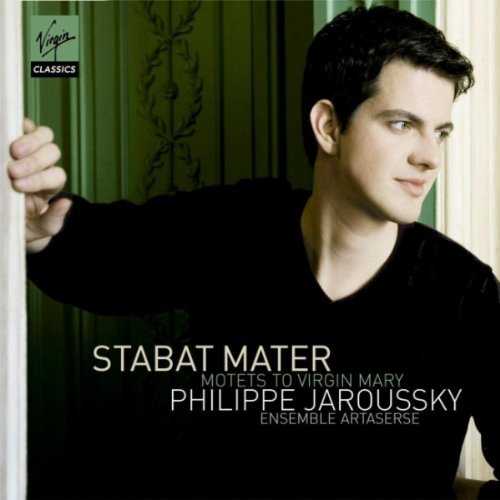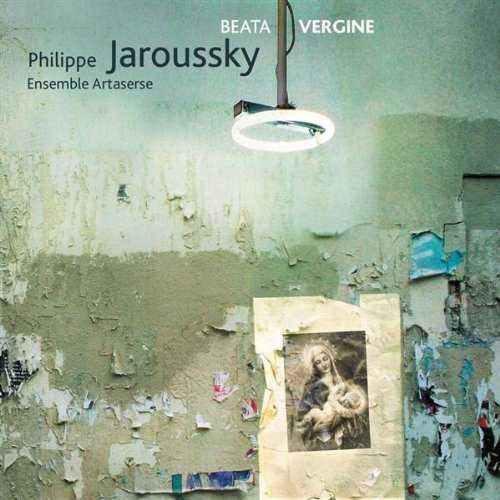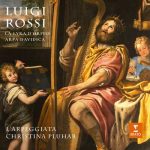
Performer: Ensemble Artaserse, Philippe Jaroussky
Composer: Sances
Audio CD
SPARS Code: DDD
Number of Discs: 1
Format: APE (image+cue)
Label: Virgin Classics
Size: 387 MB
Recovery: +3%
Scan: yes
01. Salve Regina (Motetti a una, due vocie con sinfonie d’istromenti, Libro primo, 1621, A. Vincenti, Venezia)
02. Ave Regina coelorum (Sentimenti devoti espressi con la musica di due e tre voci, opera sesta, Libro secondo, 1660, G. Sala, Venezia)
03. O quam suavis (Mottetti a voce sola da diversi Eccellentissimi Autori, Libro primo, Venezia Gardano 1645)
04. Regina coeli laetare (Motetti a voce sola, 1643, Magni, Venezia)
05. Vulnerasti cor meum (Armoniae cantiones una, 2, 3, 4, 5 vocibus concinendae cum sonorum concentibus pro instrumentis, opus tertium, 1635, G. Rolla, Milano)
06. Inno Ave Maria Stella (Il Secondo libro di toccate, canzone, versi d’inni, magnificat, gagliarde, correnti e altre partite, d’intavolatura di cimbalo e organo di Girolamo Frescobaldi organista in San Pietro di Roma, 1637)
07. Stabat Mater dolorosa (Motetti, 1636)
08. Corda lingua in amore (Metri sacri, resi armonici in motetti a voce sola con violini, opera ottava)
09. O quam tu pulchra es (Cantio sacra 1628. R. Ewerhart, Köln)
10. Sonata prima (instr.)
11. O intemerata (Il secondo libro de motetti a due, tre e quattro voci, Venezia, A. Vincenti, 1627)
12. Ave Regina coelorum (Harmonia sacra, dedota dal concerto di salmi, motetti, inni e antifone a voce sola. Con violini. 1765, A. Gardano, Venezia)
13. Sanctissima Virgo (Sacrae cantiones una, duabusque vocibus coninendae, 1618, J. Cassiani, Modena)
14. O coeli devota (Motetti sacri a voce sola con due violini, 1681, G. Monti, Bologna)
Sensualilty meeting with Celestial love
The first surprise with this CD is that it does not contain one note by Monteverdi and it is true it is mostly Italian composers from the next century, the 17th century. Apart from the Stabat Mater Dolorosa by Sances, the other pieces are from a vast array of composers and also different styles like Legrenzi in the second track that treats his “Ave Regina Coelorum” as a duet from some imaginary and tender country of love, more courteous and refined than a religious piece. Cavalli’s “O quam suavis” takes us down into a tenebrae that turns slightly resigned. It is a very dark atmosphere indeed that only lightens at the end, and not that much after all. Jaroussky’s voice is perfect in these in-between impressions of curbed emotions and dark feelings.
Rigatti’s “Regina coeli laetare” could be joyous all along except that when we beg Mary to speak to her son on our behalf, a slightly sad coloration is introduced, showing that it is not as simple as being resurrected and then saving the whole world. We still have a lot to be humble about. Caprioli’s “Vulnerati cor meum” is a love declaration to Mary and that love which will never be fulfilled carnally is poignantly sad in its very joy and the voice is the only means to express the absolute happiness of someone who has been reminded that this love leads only to an accepted death.
Sances’ “Stabat Mater dolorosa” provides us with a miracle and a second surprise. The miracle is the sky-high sky-clear voice and the surprise is that it is a male voice that sings that piece. We have been used so much to have Stabat Mater sung by women that we believe more or less tat it is a woman talking to Mary, a woman talking to another woman, but that is not at all the truth. It is a man who is speaking to Mary and that man is trying to climb up to Mary to speak to her in some level equal terms that enables him to shift from compassion and love for that suffering mother to someone who is asking her to guarantee his future after death. The ecstatic beginning that describes the death of Jesus and the suffering of the mother at the foot of the cross is followed in the third stanza with a deep music, somber behind the clear voice that is tortured in expressing suffering in notes of light. That contrast is amplified in the fourth stanza between the music and the voice that integrates the somberness in its modulation. In the seventh stanza a change appears when the poem shifts from describing the death of Jesus and the pain of the mother to the reason why Jesus got crucified: to save people. The seventh stanza the stanza of the resurrection, His resurrection probably but here our resurrection.
In the ninth stanza (the right number, the ninth hour, the death of Jesus) the poet introduces himself and starts asking the mother to help him in his own lot, and this re-centering of the poem on the “I” of the poet is audible in the singing that becomes more inward oriented, expectative more than contemplative. Then stanza thirteen (“I will make you the thirteenth” says Jesus to Judas) the first person of the poet is the very center and object of the poem, the passion is the only way to achieve salvation and it has to be integrated in the poet’s mind and Mary is supposed to help. The fact that a man is singing that part that can only be the part of a man, gives to the poem a new dimension that is a lot less visible when it is a woman who sings: the poem is the begging of a man who wants to be saved no matter what and is ready to humiliate himself to the utmost if necessary. And he closes the poem with no longer Jesus’ dead body on the cross but with his banal dead body waiting for burial, and his soul expecting salvation. The first two lines of this twentieth stanza are deep and obscure like an uncertain future, but it explodes in a word of light and a high flying note on the word “Paradisi” repeated three times (the proper number) with lengthening variations on the last two syllables and finding its fundament in the final “gloria” and “Amen”
Bassani’s “Corda lingua in amore” is built like some love song to Mary, some love scene in an opera. The Virgin is thus some mental and spiritual character of a baroque miracle play of sorts. The fourth aria is an explosion of passion and desire. It is a real love song to Mary, joyous, light, intense. The end is more respective of the superior position of Mary.
Grandi’s “O quam pulchra es” is an echo of the Song of Songs and that’s exactly what it is. Total love but in many ways unrequited or simply not deserving an answer, hence the last very nostalgic notes. The duet “O intemerata” makes the male voice completely unable to climb to any satisfaction and the female voice dominates and puts that man back in its adoring place that has to be adoration and not sensual love. The duet though gives that sensual dimension a strength that can only end in frustration. I will skip Mattioli and Casati who are like a transition to the last piece, Colonna’s “O coeli devota”, in which the Holy Virgin is a spiritual and celestial being celebrated on earth with the help of all the angels of the firmament. Then the drama of the Passion is beyond us and we float into felicity.
Dr Jacques COULARDEAU, University Paris 1 Pantheon Sorbonne, University Paris 8 Saint Denis, University Paris 12 Créteil, CEGID




Dear Whatever,
Jaroussky is one of my most favoured counter, his voice is clear, his technique effortless and translucent with a large tonale width – a marvellous guy!
Thank You very much for this fine tresure!
Joli pali, kak mozhno tak petj, ….. kak angel!? Sposibo, druzhishtshe, za eto!
Greatings from Germany to Russia
Andi
ahahahahah :D Joli pali :D
you are welcome! ;)
C’est le même enregistrement que le CD Beata Vergine paru en 2006 (Virgin 00946-344711-2-1) http://www.amazon.com/Philippe-Jaroussky-Giovanni-Battista-Bassani/dp/B000BU997E
La bobine angélique de Jaroussky est-elle mieux vendeuse que le mur décrépit d’origine ?
En tout cas, disque ma-gni-fique :-)